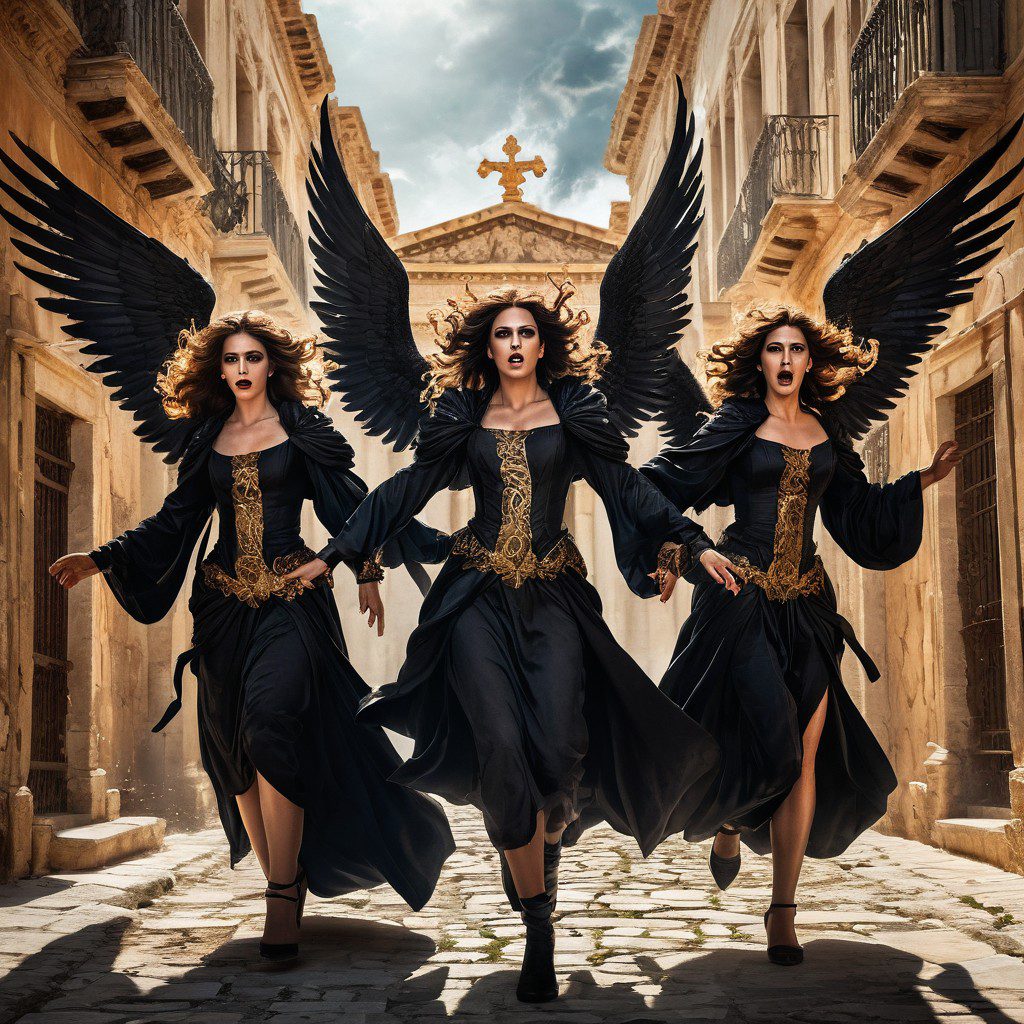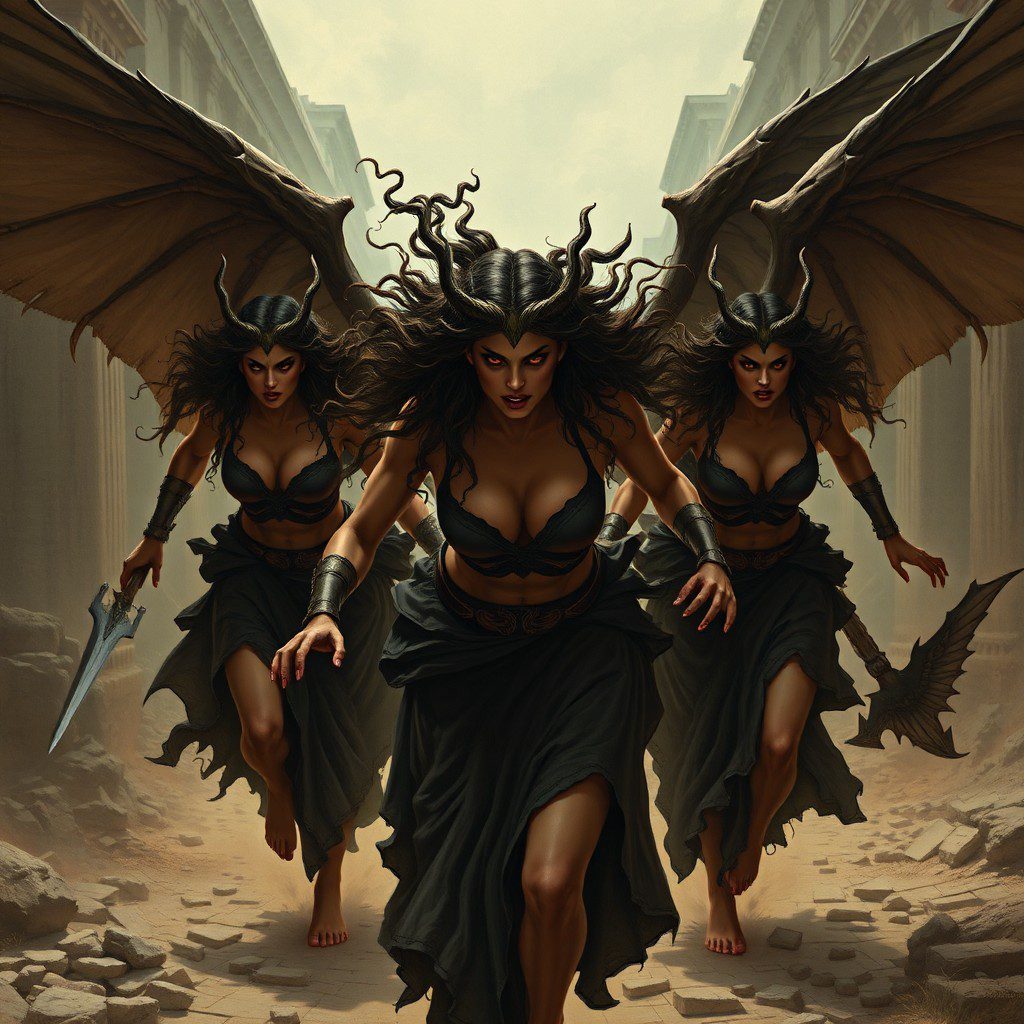The Furies: Avenging Spirits of Wrath and Justice

The Furies, also known as the Erinyes in Greek mythology, are some of the most fearsome and fascinating figures of ancient lore. These goddesses of vengeance embodied the wrath of the gods and the moral forces that punish those who commit the gravest crimes—especially those offenses that break familial bonds like murder, perjury, or impiety. Their presence in mythology is as old as the gods themselves, tracing back to the primordial beings of Greek cosmogony.
In both ancient literature and modern media, they have maintained their reputation as relentless agents of justice, striking terror into the hearts of mortals and even gods alike. But let’s dig deeper into their history, personalities, and continued impact on popular culture.
Origins and Cultural History of the Furies
The Furies are thought to have originated from Erinyes, which translates to “the angry ones” in Ancient Greek. Their lineage ties them to primordial deities—according to Hesiod’s Theogony, they were born from the blood of Uranus (the sky god) when he was castrated by his son Cronus. From this violent act of retribution, the Furies arose as personifications of vengeance itself. This link to the Earth makes them older than the Olympian gods, a critical point when considering their influence and authority over even the most powerful deities.
In other versions of their origin, particularly Aeschylus’s Oresteia trilogy, they are not so much born from a singular violent act but are eternal forces of justice, residing beneath the earth and summoned by wrongdoing. They have also been described as daughters of Nyx, the goddess of the night, which highlights their dark and mysterious nature.
The number of Furies varies in myth, but in later traditions, they are often depicted as a trio: Alecto (the “unceasing one”), Megaera (the “jealous one”), and Tisiphone (the “avenger of murder”). Together, they served as an omnipresent reminder that no sin against family, particularly kin-slaying or betrayal, would go unpunished.
Characteristics and Depiction in Ancient Literature
In Greek art and literature, the Furies are typically portrayed as horrifying figures, often with snakes for hair, eyes dripping with blood, and wings like bats. They carry whips, torches, or scourges, tools of punishment. Their very appearance struck fear into wrongdoers. But their role was not purely one of unrestrained anger or revenge; the Furies represented a more complex concept of justice that transcended personal grudges. They punished transgressions that endangered the moral fabric of society, particularly those related to family, oaths, and piety.
Aeschylus’s Oresteia trilogy is one of the most significant literary works featuring the Furies. After Orestes kills his mother, Clytemnestra, to avenge his father, Agamemnon, he is relentlessly pursued by the Furies for the sin of matricide. The trilogy delves deeply into themes of justice, as the Furies chase Orestes across the earth, demanding retribution for his crime. Yet, in the end, the Furies undergo a transformation. After Orestes is judged by Athena and acquitted, the Furies, in an unusual turn, are convinced to abandon their vengeance and become Eumenides—”the kindly ones”—showing their capacity to evolve from ruthless punishers to protectors of justice.
Strengths and Weaknesses of the Furies


Strengths:
- Relentless Pursuers: The Furies’ most notable trait is their unyielding nature. Once they take up a cause, they will pursue the guilty across land, sea, and even into the underworld, showing no mercy until justice is served.
- Divine Authority: Being older than the Olympians, they answer to no one but themselves and the abstract concept of moral justice. Their actions cannot be influenced by bribes or prayers, making them incorruptible.
- Agents of Moral Balance: Their presence ensured that social order was maintained by enforcing the consequences of oath-breaking, murder, or impiety, particularly when familial bonds were involved.
- Capable of Mercy: As seen in Oresteia, they are capable of transformation. While their primary function is vengeance, they are not purely destructive forces—they can evolve into protectors of the innocent or pardoned.
Weaknesses:
- Single-Mindedness: The Furies’ dedication to punishing crimes, particularly matricide, can be a weakness. Their lack of flexibility in interpretation made them dangerous even to those who committed crimes under morally complex circumstances, as seen with Orestes.
- Susceptibility to Change (Under Certain Conditions): Though largely immune to divine or mortal influence, in certain situations—like Orestes’ trial—they can be convinced to abandon their pursuit, which might be seen as a flaw in their relentless pursuit of justice.
- Terrifying Appearance: Their grotesque and terrifying forms could make them more isolated from the rest of the pantheon and society. Though this might enhance their aura of fear, it also separates them from the human world.
The Furies in Modern Media
The Furies, or characters inspired by them, appear throughout modern storytelling in movies, television, and video games, often representing the same themes of vengeance, justice, and moral retribution.
- Video Games:
- The God of War series prominently features the Furies as key antagonists. In God of War: Ascension, the three Furies—Alecto, Tisiphone, and Megaera—act as the enforcers of the Olympian oath. They relentlessly hunt down Kratos for breaking his blood oath to Ares. True to their mythological roots, they are depicted as brutal, unyielding, and terrifying, embodying their original function as agents of vengeance.
- Film:
- In the Percy Jackson series (The Lightning Thief in particular), the Furies take on the role of enforcers of Hades’ will, attempting to capture Percy for a crime he didn’t commit. The film’s depiction stays true to their mythological roots as terrifying, bloodthirsty creatures who hunt their prey without rest.
- Television:
- The Furies make several appearances in the long-running TV series Charmed, where they are depicted as demons who punish wrongdoers and emit poisonous gases. The show ties into their mythological role as bringers of justice but adapts their appearance and function for a more supernatural-modern setting.
- Literature:
- Rick Riordan’s Heroes of Olympus series features the Furies prominently, where they continue to act as guardians of the underworld and hunters of those who defy the gods. Their role is closely aligned with ancient myth, but they are more approachable and interact with the protagonists in a somewhat more nuanced way than in traditional stories.
The Duality of Vengeance and Justice
The Furies’ ability to inspire fear and enforce justice has remained relevant across centuries, showing how fundamental the concepts of retribution and moral order are in human culture. While their origins are steeped in violence, as symbols, they represent the balance between the chaos of revenge and the necessity for a societal rule of law. They remind us that justice, though harsh, is essential for maintaining moral and social order. Yet, they also show that vengeance must evolve—it can transition from brutal punishment to forgiveness and protection, as seen in their transformation into the Eumenides.
Their legacy lives on in modern media, from comic books to cinema, as characters that embody the terrifying yet vital nature of justice. The Furies are a reminder that moral balance often comes at a great cost but is worth pursuing, no matter how long it takes.
